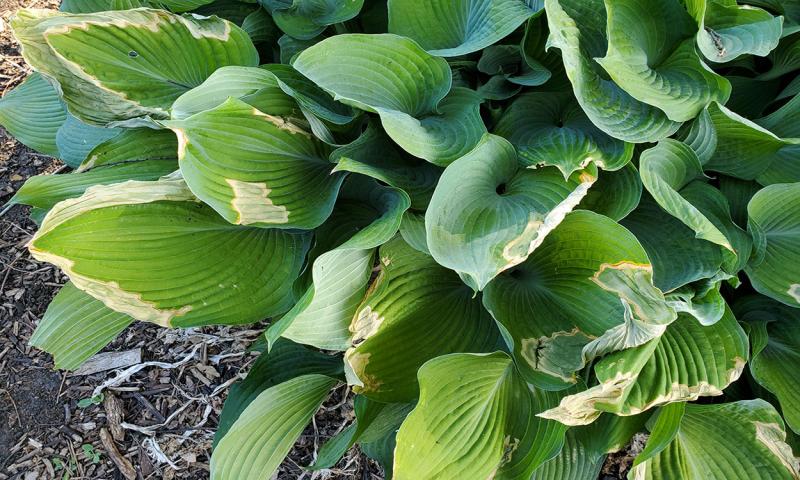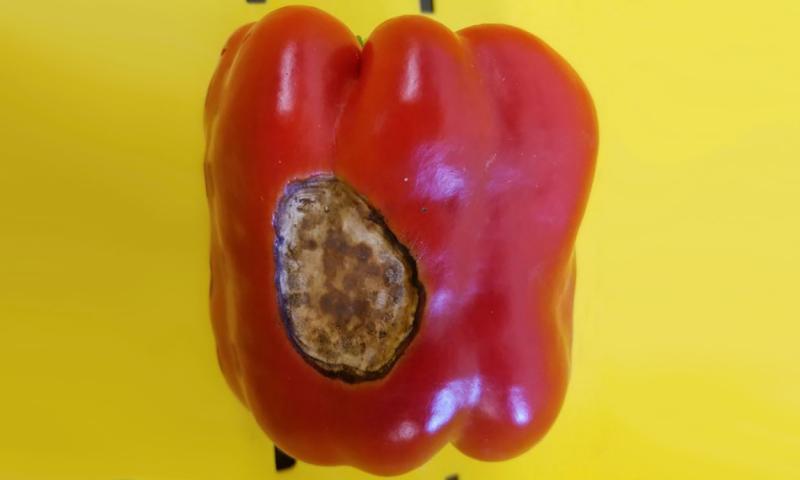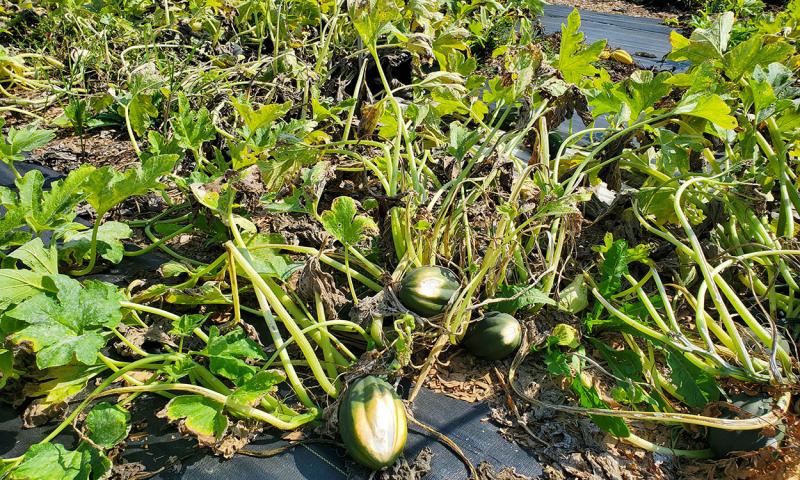
Long stretches of abnormally hot and dry weather will upset the growing habits of all plants and will lead to some unusual symptoms on leaves and produce in the garden. July and August are a prime time to watch for leaf scorch and sunscald.
Leaf Scorch
Leaf scorch is a condition brought on by hot temperatures, high winds and low soil moisture. Under these conditions, large volumes of water are being removed from the plant through the leaves and may not be replaced in time to prevent cellular damage. This is why minor leaf scorch occurs first along the outside edges of the leaves (Figure 1).

The plant is not dying, it is just trying to survive. Sometimes leaf scorch symptoms can be mistaken for a disease, so it’s important to note weather conditions when diagnosing plant issues. It is also important to remember that leaf scorch is more about water movement and less about direct sunlight exposure. For example, hostas that are sufficiently shaded may still have leaf scorch symptoms if weather is incredibly hot and dry (Figure 2).
Once leaf tissue is scorched, the damaged areas will not recover; however, minor damage, while unsightly, will not kill the plant. Leaves with scorched margins may look unappealing, but they still help the plant with photosynthesis, creating food for new, undamaged leaves to emerge. Resist the urge to remove scorched leaves. Strange as it may seem, they provide some shade for the new growth and remaining green tissue can still contribute to photosynthesis for production of new leaves. The plant’s appearance will perk up when new growth begins, and once new leaves have emerged, you could gently remove the scorched leaves if they have not already fallen off naturally.
Sunscald

Sunscald refers to damage on fruits and vegetables that is a result of high temperatures, intense solar radiation or a combination of the two factors. You may have heard the terms “sunburn” and “sunscald” used interchangeably, although “sunscald” is the more commonly used term when referring to damage of produce. Sunscald can affect a wide variety of fruits and vegetables, including watermelons, tomatoes, peppers, eggplant, cucumbers, squash, apples, strawberries, blackberries and raspberries. There are three general categories of sunscald that affect fruits and vegetables.
Sunscald Necrosis
Sunscald necrosis affects many fruits and vegetables when temperatures exceed 100 degrees Fahrenheit. The resulting damage is the complete death of skin, peel or fruit tissue where direct sun exposure has occurred. The injury may be white or brown in color and can appear as small to medium lesions. The areas will be mushy in appearance due to the cellular damage that has occurred (Figure 3). These fruits would not be marketable in a commercial setting and even may be unappealing for consumption at home.

Sunscald Browning
Sunscald browning occurs at slightly lower temperatures and does not result in death of plant cells, but rather slight damage and discoloration. The fruit or vegetable skin will have a yellow, bronze or brown spot on the sun-exposed side. Unlike damage from sunscald necrosis, discolored areas resulting from sunscald browning usually remain firm.
Photooxidative Sunscald
Photooxidative sunscald occurs when shaded fruit suddenly gets exposed to sunlight. This damage can occur at much lower temperatures and is typically a result of intense sudden light exposure. This is the same type of damage that occurs on the leaves of transplants that are not properly hardened off.

Photooxidative sunscald damage results in large areas of fruit that appear bleached and are completely white in color. These bleached areas will often appear sunken, and outer tissue may be soft. It may wrinkle and develop secondary decay.
There are several ways that photooxidative sunscald damage can occur. Late-season pruning of tomatoes and peppers can suddenly expose maturing fruit to sunlight.
Summer storms that damage foliage can also suddenly expose shaded fruit to sunlight after the storm (Figure 5). Tomatoes that are exhibiting physiological leaf roll may also have fruit that is damaged by photooxidative sunscald.
Preventing and Managing Leaf Scorch and Sunscald
There are ways to prevent leaf scorch and sunscald in your garden. Providing adequate water to your plants is critical, especially on extremely hot, windy days. Maintaining plant vigor also increases foliage that shades fruit, reducing light exposure and temperature of the fruit itself. An organic mulch around your plants can conserve soil moisture and reduce the soil temperature for the plant roots. Lastly, on extremely hot days, temporary shading of foliage and fruit could reduce water loss as well as the temperature of the plant itself to prevent or reduce damage. Kaolin clay, available in spray formulations, can be sprayed on fruit to protect it from sunscald. It will need to be washed off after harvest, so it will not be appropriate for soft fruit, such as berries. Always follow the label directions carefully!
All three types of sunscald damage to fruits and vegetables can be superficial. However, sunscald damage could worsen in extreme weather, causing damage to spread and fruit to drop prematurely. Also, fruit with sunscald damage can become host to a secondary disease or infection. The best thing to do when you notice small amounts of sunscald damage is to remove the fruit. Immature fruit with damage can be composted or discarded. If the fruit is mature, cut out the damaged section and eat it promptly.
When the weather outlook shows more hot, dry, windy days ahead, it is impossible to prevent all damage. But, by knowing the signs of sun damage and preparing, you will be able to save your plants throughout summer heat waves.
References and Resources
- Ernest, Emmalea Garver. 2019. University of Delaware Weekly Crop Update. Sunburn in Vegetables Revisited; Use of Particular Films.
- The Morton Arboretum. 2021. Leaf Scorch.
Special thanks to SDSU Extension Master Gardeners Tim Schreiner and Stacy Dreis for serving as volunteer copyeditors of this article.


